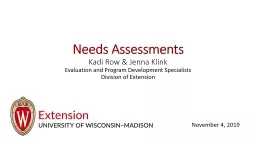

Evaluation and Program Development Specialists Division of Extension November 4 2019 Overview of todays content The what and why of needs assessments 3 main steps to conducting a needs assessment ID: 806817
Download The PPT/PDF document "Needs Assessments Kadi Row & Jenna K..." is the property of its rightful owner. Permission is granted to download and print the materials on this web site for personal, non-commercial use only, and to display it on your personal computer provided you do not modify the materials and that you retain all copyright notices contained in the materials. By downloading content from our website, you accept the terms of this agreement.
Slide1
Needs AssessmentsKadi Row & Jenna KlinkEvaluation and Program Development SpecialistsDivision of Extension
November 4, 2019
Slide2Overview of today’s contentThe what and why of needs assessments3 main steps to conducting a needs assessment
Further tips and resources
Slide35 key points They are not a one and done
They are collaborative efforts It’s important to have multiple sources
Assets are as important as needs
There is help!
Slide4Rad Resource
Slide5Why/when have you done a needs assessment?
Slide6What is a needs assessment?Process to identify what people/communities need and what assets exist
Used to focus a responseNot just a one and done
Credit:
Needs Assessment Guidebook for Extension Professionals
2016. Donaldson & Franck. Univ. of Tennessee Extension PB 1938
Slide7Why needs assessment?Gain deeper understanding of the community
Understand the context in a more objective wayIdentify both needs and assetsEffectively plan your programming, focus your response
Slide8Understand the contextSeek to understand the issue, opportunity, or situation from multiple perspectives.
What is the issue, opportunity, or situation? Who is defining this? Who should be?What things are assumed to be true about the context?What is the context surrounding the issue, state of affairs, opportunity, and situation?
Slide9Who’s needs?A particular audience (Farmers? Families?)
A particular geography (County? Community?)Interface with other key players/stakeholders
Slide103 Steps to a Needs AssessmentStep 1: Exploration of existing data
Keep your exploration focused on the purpose of your needs assessment What do you (or others) already know? Do you need additional information?
Who else needs to be involved? Consider a Needs Assessment Committee
Credit:
Needs Assessment Guidebook for Extension Professionals
2016. Donaldson & Franck. Univ. of Tennessee Extension PB 1938
Slide11Using an Need Assessment Committee for needs assessment
Who should be involved?What is their role?
Slide123 Steps to a Needs Assessment
Step 2: Assessment What new data do you need?
Who do you commonly get data on needs from?
Who aren’t you currently reaching and how might your learn from them?
What methods will help you get it?
Credit:
Needs Assessment Guidebook for Extension Professionals
2016. Donaldson & Franck. Univ. of Tennessee Extension PB 1938
Slide13All methods have strengths and limitations
Credit:
Needs Assessment Guidebook for Extension Professionals
2016. Donaldson & Franck. Univ. of Tennessee Extension PB 1938
Slide143 Steps to a Needs Assessment
Step 2, con’t.: Assessment Don’t collect information that you don’t intend to use Use multiple methods to triangulate
Pilot your methods
Document what you are learning
Credit:
Needs Assessment Guidebook for Extension Professionals
2016. Donaldson & Franck. Univ. of Tennessee Extension PB 1938
Slide153 Steps to a Needs AssessmentStep 3: Utilization
This is the concrete tie to program planning Use what you learn to set program priorities Develop educational response
Credit:
Needs Assessment Guidebook for Extension Professionals
2016. Donaldson & Franck. Univ. of Tennessee Extension PB 1938
Slide16Cautions and caveats in utilizationDisregarding issues
Allowing undue influenceFocus was too narrow or too broadRelying on only one data source
Credit:
Needs Assessment Guidebook for Extension Professionals
2016. Donaldson & Franck. Univ. of Tennessee Extension PB 1938
Slide17Resources to help you – Planning Worksheet
Slide18Resources to help youPDE website – UW-Madison, Division of Extension
Needs Assessment Guidebook – UTenn ExtensionProgram Development & Evaluation Specialists
Josset
Gauley
(CD and PYD)
Jenna Klink
(HDR)
Kadi Row
(AG and NR)
Shannon Sparks
(HWB)
Colleagues in Extension Office of Access, Inclusion, and Compliance
Your Program Manager
Slide19Role of Program ManagerIt’s a 2-way street
Program Manager: Can help develop methods/tools for needs assessments Provides guidance for programmatic responseLocal Educators:
Have local insights to inform Program/Institute plans
Understand your audience/community
Slide205 key points about Needs Assessments
They are not a one and done They are collaborative efforts It’s important to have multiple sources
Assets are as important as needs
There is help!
Slide21Assessment poll